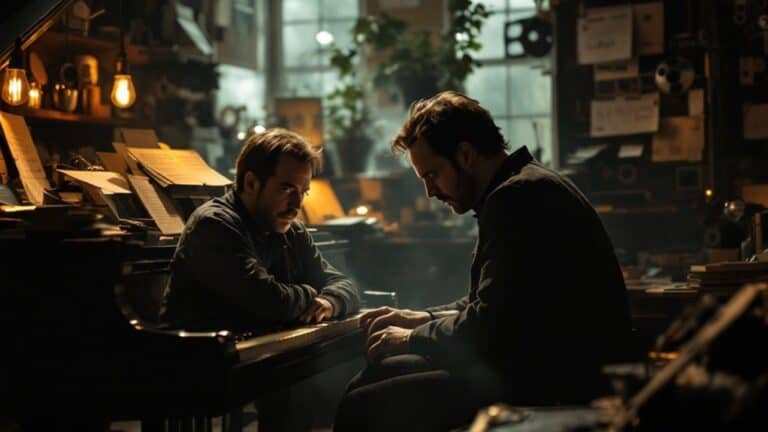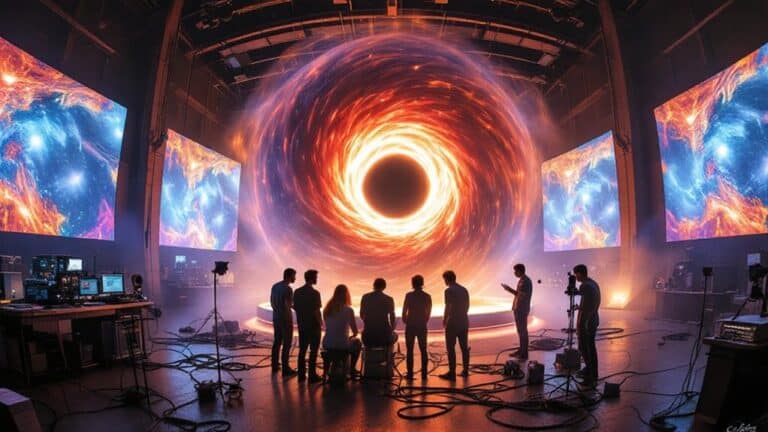Interstellar’s Scientific Accuracy: What NASA Thinks About the Film
“Interstellar” captivates audiences with its stunning visualization of black holes, largely thanks to NASA’s recognition of its scientific accuracy. Collaborating with physicist Kip Thorne, the film vividly portrays complex phenomena like gravitational lensing and time dilation, grounding its narrative in real theoretical concepts. While artistic liberties exist for dramatic storytelling, the core principles resonate with current scientific understanding, inspiring curiosity about the universe. NASA values the film as a catalyst for public interest in astrophysics and space exploration, illustrating how art and science can harmonize. There’s more to uncover about how this film shapes scientific dialogue and excitement for the cosmos.
Table of Contents
Overview of Scientific Accuracy
When it comes to “Interstellar,” the film stands out for its remarkable scientific accuracy, especially in its portrayal of black holes and gravitational phenomena. By collaborating with renowned physicist Kip Thorne, the filmmakers guaranteed a level of scientific representation that resonates with viewers yearning for authenticity.
The depiction of Gargantua, the film’s black hole, mirrors real-world images captured later, showcasing groundbreaking visual effects that bring cinematic realism to life. The dramatic, warped appearance of the accretion disk reflects the intense gravitational forces at play, creating a striking visual experience that’s both beautiful and scientifically accurate. Gargantua’s design took approximately 100 days of computational time for each second of footage, highlighting the film’s commitment to visual fidelity.
While there are minor compromises for aesthetic reasons, like altering color tones, the film successfully balances scientific rigor with storytelling. Neil deGrasse Tyson praised this balance, highlighting the film’s exceptional portrayal of gravitational lensing and the bending of light around massive objects. Additionally, the film accurately explores extreme time dilation experienced by astronauts near Gargantua, emphasizing how strong gravity affects time perception.
In “Interstellar,” you see how science can enhance narrative, drawing you deeper into the experience. It’s a cinematic journey that connects you to the mysteries of the universe, inviting you to ponder the vastness of space while remaining grounded in scientific principles.
Key Theoretical Concepts
Building on the film’s impressive scientific accuracy, “Interstellar” introduces several key theoretical concepts that play a significant role in its narrative. One of the most intriguing ideas is the concept of wormholes, which could serve as shortcuts through spacetime, connecting two distant points in the universe. However, wormhole stability remains a significant challenge, as these theoretical passages would require exotic matter or negative energy to remain open for travel, a fascinating yet complex idea that engages our imaginations.
On the other hand, black hole dynamics are portrayed with remarkable attention to detail. The film’s depiction of the black hole Gargantua offers a striking visual representation, showcasing gravitational lensing and the extreme warping of spacetime effects experienced near such massive objects. Additionally, the film’s narrative suggests that future humans are manipulating past events to ensure their survival, which adds a layer of complexity to our understanding of time.
While the film does take some liberties for dramatic effect, it successfully communicates the mind-bending realities of black holes.
As you dive deeper into these concepts, you may find yourself reflecting on humanity’s place in the cosmos, grappling with the mysteries of time and space. “Interstellar” not only entertains but also challenges you to ponder the theoretical boundaries of our understanding of the universe.
Kip Thorne’s Contributions

How did Kip Thorne shape the scientific foundation of “Interstellar”? As an executive producer and theoretical physicist, Thorne’s theories guided the film’s intricate portrayal of cosmic phenomena. He collaborated closely with director Christopher Nolan to guarantee that concepts like wormholes and black holes adhered to scientific principles, working for cinematic realism that resonates deeply with audiences.
By developing the initial concept alongside producer Lynda Obst, Thorne laid the groundwork for a story rooted in plausibility. His dedication to accuracy is evident in his book, “The Science of Interstellar,” where he elaborates on the scientific phenomena depicted in the film. Thorne even modeled the fictional black hole, Gargantua, as a spinning entity, showcasing how it could create stunning visual effects while remaining grounded in physics. This attention to detail not only enhances the film’s narrative but also enriches our understanding of gravitational effects and time dilation, making complex theories accessible to viewers.
Through his contributions, Thorne not only elevated “Interstellar” but also ignited a broader interest in scientific concepts, proving that cinema can serve as a powerful medium for exploring the wonders of the universe. The film’s portrayal of dimensional physics has sparked debates within the scientific community, showcasing the interplay between entertainment and scientific accuracy.
NASA’s Perspective
Kip Thorne’s collaboration with filmmakers not only enriched “Interstellar” but also caught the attention of NASA, which recognized the film’s scientific merit. This partnership led to groundbreaking scientific collaborations, resulting in visualizations of black holes that mirrored what you saw on screen. NASA insights revealed that the film’s depiction of gravitational effects, including time dilation, resonates with their research in general relativity and black holes.
When you consider how *Interstellar* accurately portrayed complex concepts, it’s clear why NASA researchers have lectured on “The Science of Interstellar.” They appreciate how the film can bridge the gap between intricate science and public understanding. The excitement generated by the film has sparked interest in space exploration, encouraging people like you to engage with theoretical physics. Additionally, the collaboration with scientists like Kip Thorne has helped in refining black hole models for cinematic representation. Furthermore, the film’s portrayal of black holes with realistic accretion disks has set a high standard for future space films.
Moreover, the collaboration has set a new standard for science fiction, demonstrating that accurate scientific representation can inspire and educate. By aligning their interests with those of filmmakers, NASA has fostered a community that values scientific accuracy.
This connection not only enhances cinematic experiences but also strengthens the public’s relationship with science, making it feel more accessible and relevant to your life.
Black Hole Visualization

In the domain of astrophysics, black hole visualization has become an intriguing intersection of science and art, enchanting audiences with its stunning imagery. You might be surprised to learn that advanced techniques, like black hole simulations and rasterization-based rendering, play a vital role in creating these mesmerizing visuals. Films such as *Interstellar* employed these methods to depict black holes realistically, even before the first actual images were captured.
At the heart of these visualizations lies a scientific foundation, drawing from our understanding of accretion disks and gravitational lensing. When you watch *Interstellar*, you’re experiencing a meticulously crafted representation, where the intense gravitational forces warp the appearance of the accretion disk and bend light around the black hole. This accuracy was achieved through consultations with renowned physicist Kip Thorne, ensuring that the film’s depiction aligns with current scientific knowledge.
These visualizations not only inspire awe but also serve educational purposes, fostering a deeper understanding of black holes and their effects on the fabric of space and time. By blending science and art, we’re invited to explore the universe in ways that spark curiosity and ignite a sense of belonging in the vastness of the cosmos.
Time Dilation Explained
Time dilation is a fascinating phenomenon that reveals how time can flow differently depending on your speed or gravitational field. Imagine a world where your clock ticks slower than your friend’s merely because you’re moving faster or standing near a massive object. This concept isn’t just theoretical; it’s rooted in the physics of relativity.
- Time can stretch or compress based on speed.
- Clocks in different gravitational fields can’t be synchronized.
- Space travelers could age less than those on Earth.
- Real-world experiments have confirmed time dilation.
When you think about time dilation, you realize its implications for space travel and our understanding of the universe. For instance, as you approach the speed of light, you experience months in space while years pass on Earth.
This raises intriguing questions about clock synchronization; two clocks in different frames can never align perfectly, making our perception of time deeply personal and subjective.
As you reflect on these concepts, it becomes clear that time isn’t just a constant; it’s a variable intertwined with the very fabric of reality, shaping not just physics, but our own experiences and connections with others.
Educational Impact

While exploring the vastness of space through “Interstellar,” you not only engage with thrilling storytelling but also discover a wealth of educational opportunities. The film serves as a catalyst for educational engagement, offering lesson plans developed in collaboration with Google that span various subjects, including science, physics, and environmental studies for grades 6 to 12.
These resources promote interdisciplinary learning, allowing teachers to connect concepts across disciplines, enriching students’ understanding of complex topics. Hands-on activities, like simulating gravitational effects or constructing biospheres, transform theoretical knowledge into tangible experiences, sparking curiosity and creativity.
The film’s accurate portrayal of black holes and wormholes provides a unique platform for teaching fundamental astrophysics concepts, making challenging theories more accessible and relatable. Moreover, the official educational website enhances this experience, offering quizzes and games that further elucidate special relativity.
As you immerse yourself in the science behind the film, you’ll find it not only inspires intellectual pursuit but also encourages a sense of belonging to a broader community passionate about exploration and discovery, ultimately paving the way for future generations to engage with science and technology.
Real-World Discoveries
Frequent discussions about “Interstellar” often highlight its real-world impact on our understanding of black holes.
The film has become a cornerstone for black hole exploration, merging scientific storytelling with stunning visuals that inspire curiosity and wonder.
Here are a few key contributions it made:
- Accurate Visualization: The depiction of black holes was guided by physicist Kip Thorne, ensuring scientific accuracy.
- Influence on NASA: NASA’s own black hole visualizations were inspired by the film’s groundbreaking work.
- Event Horizon Telescope Validation: The images captured by the Event Horizon Telescope echoed the film’s representation of black holes.
- Gravitational Time Dilation: “Interstellar” effectively illustrated how time behaves near massive objects, a concept that resonates with audiences.
Science Communication in Film

Science films like “Interstellar” serve as powerful tools for communicating complex scientific concepts to the public. Through engaging narratives and stunning visual storytelling, these films can captivate audiences, making science more relatable and accessible. When a film weaves an intricate story around scientific principles, it transforms dry concepts into riveting experiences, encouraging audience engagement.
By combining emotive imagery with cutting-edge scientific research, films like “Interstellar” create a bridge between art and science. This connection not only enhances understanding but also fosters a sense of belonging among viewers, who might feel intimidated by traditional scientific discourse. The cinematic experience immerses you in a world where complex ideas are visualized, allowing for a deeper emotional connection.
However, the effectiveness of these films can depend on factors like narrative voice and content framing. If the story resonates with you, the science becomes easier to grasp, leading to a greater appreciation for the subject.
Ultimately, science films have the potential to reshape public perception, reduce stereotypes about scientists, and inspire curiosity, proving that storytelling and visual techniques can greatly enhance science communication.
Inspiring Future Scientists
Films like “Interstellar” not only entertain but also play a pivotal role in inspiring future scientists. By blending storytelling with scientific accuracy, it ignites curiosity and fosters a sense of belonging in the scientific community. Here are some ways it does this:
- Gravitational time dilation fascinates viewers and encourages them to explore Einstein’s theories.
- The stunning visuals of black holes spark interest in theoretical physics and space exploration.
- The film’s balance between science and aesthetics makes complex concepts accessible.
- Accurate representations of astrophysical phenomena inspire admiration and wonder.
“Interstellar” serves as a bridge between science and popular culture, showing how enthralling our universe can be. The film’s commitment to scientific principles invites you to think critically about the universe, potentially guiding your future careers in science or engineering.
It’s not just about watching; it’s about engaging with ideas that challenge your understanding of reality. The film encourages you to envision a future where you might contribute to scientific discoveries, fostering science inspiration in an emotionally resonant way.
Conclusion
In exploring “Interstellar,” you’ve glimpsed the cosmos through both artistic vision and scientific rigor. Kip Thorne’s insights and NASA’s endorsement reveal a tapestry where imagination meets reality. This film doesn’t just entertain; it ignites curiosity and inspires you to ponder the universe’s mysteries. Like a black hole bending light, “Interstellar” warps your perception of science, inviting you to dream big while grounding those dreams in the wonders of astrophysics. The journey of discovery has only just begun.







